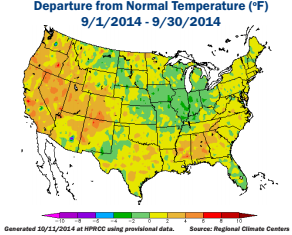C. Harvest Conditions (September – October +)
Cool, wet weather delayed maturation and harvest; up to 30% had early freeze
At the end of the growing season, dry down of the grain is dependent upon sunshine, temperature, humidity levels, seed hybrid and soil dryness. Corn can most effectively dry down with the least adverse impact on quality with sunny, warm days with low humidity. Another weather concern at the end of the growing season is freezing temperatures. Early freezing before the grain can sufficiently naturally dry down may lead to lower yield, lower test weight, and/or stress cracking. Also, if harvested early, higher-moisture grain may be susceptible to greater breakage than drier grain.
Typically, 80% of the U.S. corn crop is harvested by the end of October. However, in 2014, the cool summer temperatures initially delayed maturity. Harvest was further delayed by rainy weather and continued cool temperatures, primarily in the Gulf and Pacific Northwest ECAs, but also in the eastern half of the Southern Rail ECA. There was a scattered early freeze in mid-September in the northern Gulf and Pacific Northwest ECAs, affecting less than 3% of the corn crop. However, the crop experienced a more widespread freeze and snowfall in early October, this time affecting 20% of the corn production area. At that time, approximately 30% of the corn crop was not at full maturity and susceptible to frost damage, which could include reduced yields, lower test weights and stress-cracking, and may take a longer time to dry down. Producers also may artificially dry this grain. Alternatively, these plants may be harvested for silage, thereby removing the lesser-quality grain from the market stream.
